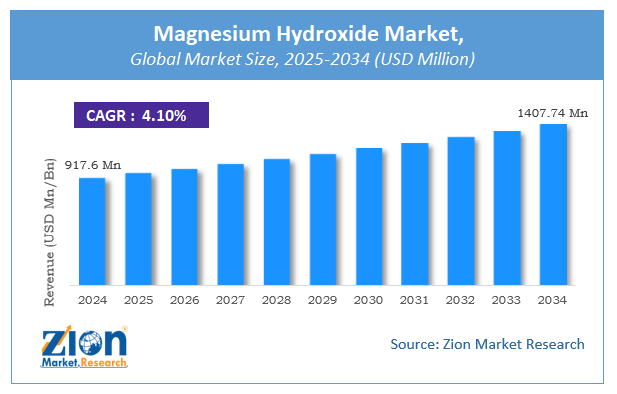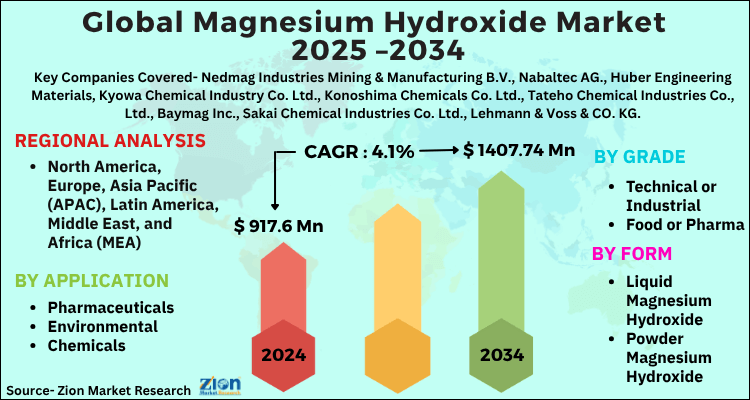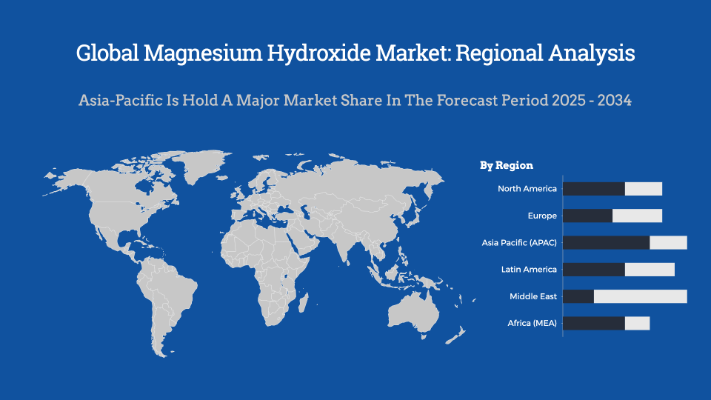Global Magnesium Hydroxide Market Size, Share, Growth Analysis Report - Forecast 2034

Magnesium Hydroxide Market By Form (Liquid Magnesium Hydroxide, Powder Magnesium Hydroxide), By Application (Wastewater Treatment, Pharmaceuticals, Flame Retardants, Chemicals & Others, Fuel Additives, Food & Feed, Abrasives, Others), By Grade (Industrial, Food, Pharmaceutical), and By Region: Global and Regional Industry Overview, Market Intelligence, Comprehensive Analysis, Historical Data, and Forecasts 2025 - 2034
| Market Size in 2024 | Market Forecast in 2034 | CAGR (in %) | Base Year |
|---|---|---|---|
| USD 917.6 Million | USD 1407.74 Million | 4.1% | 2024 |
Global Magnesium Hydroxide Market: Industry Perspective
The global magnesium hydroxide market size was worth around USD 917.6 Million in 2024 and is predicted to grow to around USD 1407.74 Million by 2034 with a compound annual growth rate (CAGR) of roughly 4.1% between 2025 and 2034. The report analyzes the global magnesium hydroxide market's drivers, restraints/challenges, and the effect they have on the demands during the projection period. In addition, the report explores emerging opportunities in the magnesium hydroxide industry.
Global Magnesium Hydroxide Market: Overview
Magnesium hydroxide is a popular and versatile inorganic compound as it does not contain carbon-hydrogen bonds. The chemical formula for the compound is Mg(OH)2. In nature, magnesium hydroxide is available as the mineral brucite which is a low-temperature hydrothermal vein mineral. Mg(OH)2 appears as a white solid and exhibits low water solubility. It has wide applications in end-user verticals including the healthcare and food industries. In the medicine industry, it is profoundly popular as an antacid and an active key ingredient for extensively consumed laxatives such as milk of magnesia.
Apart from these most common applications, the market is filled with several research initiatives working toward improving compound use which could lead to further growth for the market players. However, in recent times, the magnesium hydroxide market growth trend has registered specific setbacks associated with health concerns over excessive consumption of magnesium hydroxide. Nevertheless, the Mg(OH)2 outlook is projected to be steady during the forecast period as more investments pour in toward the increased production rate of the compound.
Global Magnesium Hydroxide Market: Growth Drivers
Promising application as a laxative and an antacid to drive market growth
The global magnesium hydroxide market is projected to grow owing to the promising application of the compound as a popular laxative and an antacid. It is used for treating occasional constipation in children and adults on a short-term basis and belongs to the saline laxatives class of medications. It helps in water retention in the stool resulting in an increased number of bowel movements. Magnesium hydroxide is typically available in tablet or chewable tablet form but can also be found in liquid form to be taken by mouth. It is known to cause bowel movement within 30 minutes of intake but may take over 6 hours in some cases.
The extended medical applications of magnesium hydroxide include its use as an antacid since it is known to treat conditions such as heartburn, upset stomach, and acid indigestion. Depending on the doctor's recommendation, it can be prescribed for other conditions as well. The increasing population rate and surging number of adults or children facing constipation are excellent market growth drivers. Several factors are responsible for improper bowel movement in adults including limited consumption of fiber, changes in routine or lifestyle, and not paying enough attention to the need for passing stool. As per a report by the National Institutes of Health (NIH), around 16 in every 100 people in the US exhibit constipation symptoms regularly.
Increasing construction of new Mg(OH)2 production facilities may push market growth rate
The industry for magnesium hydroxide is projected to gain higher momentum in terms of revenue due to the rising compound production rate globally and also includes strategic partnerships, acquisitions, or joint ventures. In a recent market move, RHI Magnesita (RHIM), a leading supplier of refractory products, sold its 50% stakes in Magnifin Magnesiaprodukte GmbH & Co. KG, one of Australia’s largest producers of magnesium hydroxide to J.M. Huber Corp., America's prominent corporation. The overall transaction was valued at USD 100 million and has strengthened J.M. Huber Corp’s footprint in the chemical industry
Restraints:
Health concerns over excess consumption of magnesium hydroxide may restrict market growth
The global magnesium hydroxide market growth is projected to be limited due to certain health concerns associated with the excess or unwanted consumption of magnesium hydroxide. Medical professionals recommend against magnesium hydroxide unless necessary and when prescribed, it should be consumed in advised doses. Excess amounts of magnesium hydroxide medicine can lead to severe diarrhea. Another key unwanted impact deals with high magnesium levels leading to shallow breathing, muscle weakness, mood changes, and irregular heartbeat. Patients have also complained of dehydration symptoms, rectal bleeding, abdominal pain, and bloody stools. While a serious allergic reaction to the drug is rare, significant risk still persists. These factors do not work in the favor of magnesium hydroxide medicine especially when consumed in quantities more than required.
Opportunities:
Growing applications in flue gas desulfurization (FGD) will open new avenues for expansion
During the projection period, the demand for magnesium hydroxide is projected to grow multifold as higher applications of the compound are emerging in the FDH market segment. Flue gas desulfurization deals with the use of multiple technologies and methods for the removal of toxic sulfur content such as sulfur dioxide (SO2) from exhaust flue gasses produced by power plants running on fossil fuel. It is also used for the removal of sulfur oxide-emitting processes such as petroleum refineries, incineration plants, and lime kilns. Sulfur dioxide is an extremely harmful environmental pollutant and can lead to several serious health risks including bronchitis and asthma attacks.
It has also been linked to various cardiovascular diseases (CVDs). The environmental impact of SO2 is more severe as it is directly related to the formation of acid rain that causes deforestation and hampers marine ecosystems. These events have led to governments and international environment bodies regulating the release of SO2 in the environment. For instance, as per regulations in the US, the hourly average for sulfur dioxide is 75 parts per billion. Magnesium hydroxide is used in the desulfurization process as it follows 3 simple steps to achieve the goal including absorption, oxidation, and separation.
Use of magnesia power requires more attention
Magnesia powder is used as fillings for electrical materials and this segment requires more attention from the players as it holds tremendous growth potential. Fused magnesia possesses excellent electric and thermal resistance which means it can be used to form a protective layer between the outer sheath and the element. In cable applications, it is used as mineral insulation.
Challenges:
Availability of substitutes across end-uses to challenge market growth
The magnesium hydroxide industry expansion trajectory will be challenged by the presence of an extensive market filled with alternatives to magnesium hydroxide across end-user verticals. For instance, some other popular antacids available in the market are sodium bicarbonate, calcium carbonate, proton pump inhibitors, simethicone, and others. Some of these variants are safer than magnesium hydroxide. Similarly, other substitutes for FGD are also highly prevalent leading to serious market fragmentation.
Key Insights
- As per the analysis shared by our research analyst, the global magnesium hydroxide market is estimated to grow annually at a CAGR of around 4.1% over the forecast period (2025-2034).
- Regarding revenue, the global magnesium hydroxide market size was valued at around USD 917.6 Million in 2024 and is projected to reach USD 1407.74 Million by 2034.
- The magnesium hydroxide market is projected to grow at a significant rate due to increasing demand for flame retardants, growth in wastewater treatment applications, rising environmental regulations, and expanding use in pharmaceuticals and food additives.
- Based on Form, the Liquid Magnesium Hydroxide segment is expected to lead the global market.
- On the basis of Application, the Wastewater Treatment segment is growing at a high rate and will continue to dominate the global market.
- Based on the Grade, the Industrial segment is projected to swipe the largest market share.
- Based on region, Asia-Pacific is predicted to dominate the global market during the forecast period.
Global Magnesium Hydroxide Market: Report Scope
| Report Attributes | Report Details |
|---|---|
| Report Name | Magnesium Hydroxide Market |
| Market Size in 2024 | USD 917.6 Million |
| Market Forecast in 2034 | USD 1407.74 Million |
| Growth Rate | CAGR of 4.1% |
| Number of Pages | 211 |
| Key Companies Covered | Nedmag Industries Mining & Manufacturing B.V., Nabaltec AG., Huber Engineering Materials, Kyowa Chemical Industry Co. Ltd., Konoshima Chemicals Co. Ltd., Tateho Chemical Industries Co., Ltd., Baymag Inc., Sakai Chemical Industries Co. Ltd., Lehmann & Voss & CO. KG., Martin Marietta Materials Inc., and others. |
| Segments Covered | By Form, By Application, By Grade, and By Region |
| Regions Covered | North America, Europe, Asia Pacific (APAC), Latin America, The Middle East and Africa (MEA) |
| Base Year | 2024 |
| Historical Year | 2020 to 2023 |
| Forecast Year | 2025 - 2034 |
| Customization Scope | Avail customized purchase options to meet your exact research needs. Request For Customization |
Global Magnesium Hydroxide Market: Segmentation
The global magnesium hydroxide market is segmented based on application, grade, form and region. All the segments have been analyzed based on present and future trends and the market is estimated from 2025 to 2034.
Based on application, the global market segments are pharmaceuticals, environmental, chemicals, and others. During the forecast period, the environmental segment is expected to lead the market growth as it is expected to grow at a CAGR of over 5.1%. In 2024, it accounted for more than 39% of the total share, and increasing investments in the development of sustainable solutions related to magnesium hydroxide will lead to segmental growth.
Based on grade, the magnesium hydroxide industry divisions are technical or industrial and food or pharma. The highest growth will be observed in the technical or industrial grade. The segmental growth will be a CAGR of 5.29% and may account for over 25% of the total market share. Growing applications in wastewater treatment and removal of heavy metals from wastewater may act as segment growth drivers.
Based on Form, the global magnesium hydroxide market is divided into Liquid Magnesium Hydroxide, Powder Magnesium Hydroxide.
The Regional, this segment includes the current and forecast demand for North America, Europe, Asia Pacific, Latin America,and the Middle East and Africa.
Global Magnesium Hydroxide Market: Regional Analysis
The magnesium hydroxide market shows varied regional dynamics, with Asia-Pacific dominating due to strong demand from wastewater treatment, environmental protection initiatives, and robust flame retardant applications in countries like China, India, and Japan. North America follows closely, driven by stringent environmental regulations and growing use in flue gas desulfurization and industrial wastewater treatment. Europe maintains a significant market share owing to sustainable manufacturing practices and high demand in the construction and plastics industries. Meanwhile, emerging economies in Latin America and the Middle East & Africa are witnessing gradual growth as industrialization and infrastructure projects increase the need for flame retardants and water treatment chemicals, fueling further expansion of the magnesium hydroxide market globally.
Global Magnesium Hydroxide Market: Competitive Analysis
The global magnesium hydroxide market is led by players like:
- Martin Marietta Magnesia Specialties
- Ube Industries
- Premier Magnesia LLC
- Konoshima Chemical Co. Ltd.
- Nedmag Industries
- Xinyang Minerals Group
- Kumas Manyezit Sanayi A.S.
- Russian Mining Chemical Company LLC
- NIKOMAG
- Kyowa Chemical Industry Co. Ltd.
- Naikai Chemical Industries Co. Ltd.
- RHI Magnesita
- Nedmag B.V.
- Lehmann&Voss&Co.
- ICL Group
Global Magnesium Hydroxide Market: Segmentation Analysis
The global magnesium hydroxide market is segmented as follows:
By Application
- Pharmaceuticals
- Environmental
- Chemicals
- Others
By Grade
- Technical or Industrial
- Food or Pharma
By Form
- Liquid Magnesium Hydroxide
- Powder Magnesium Hydroxide
Global Magnesium Hydroxide Market: Regional Segment Analysis
- North America
- The U.S.
- Canada
- Mexico
- Europe
- France
- The UK
- Spain
- Germany
- Italy
- Rest of Europe
- Asia Pacific
- China
- Japan
- India
- Australia
- South Korea
- Rest of Asia Pacific
- The Middle East & Africa
- Saudi Arabia
- UAE
- Egypt
- Kuwait
- South Africa
- Rest of the Middle East & Africa
- Latin America
- Brazil
- Argentina
- Rest of Latin America
Table Of Content
Methodology
FrequentlyAsked Questions
Magnesium hydroxide is a popular and versatile inorganic compound as it does not contain carbon-hydrogen bonds. The chemical formula for the compound is Mg(OH)2. In nature, magnesium hydroxide is available as the mineral brucite which is a low-temperature hydrothermal vein mineral. Mg(OH)2 appears as a white solid and exhibits low water solubility.
The global magnesium hydroxide market is expected to grow due to rising adoption in wastewater treatment, increasing demand for eco-friendly flame retardants, and growing applications in pharmaceuticals and food additives.
According to a study, the global magnesium hydroxide market size was worth around USD 917.6 Million in 2024 and is expected to reach USD 1407.74 Million by 2034.
The global magnesium hydroxide market is expected to grow at a CAGR of 4.1% during the forecast period.
Asia-Pacific is expected to dominate the magnesium hydroxide market over the forecast period.
Leading players in the global magnesium hydroxide market include Nedmag Industries Mining & Manufacturing B.V., Nabaltec AG., Huber Engineering Materials, Kyowa Chemical Industry Co. Ltd., Konoshima Chemicals Co. Ltd., Tateho Chemical Industries Co., Ltd., Baymag Inc., Sakai Chemical Industries Co. Ltd., Lehmann & Voss & CO. KG., Martin Marietta Materials Inc., among others.
The report explores crucial aspects of the magnesium hydroxide market, including a detailed discussion of existing growth factors and restraints, while also examining future growth opportunities and challenges that impact the market.
HappyClients
Zion Market Research
Tel: +1 (302) 444-0166
USA/Canada Toll Free No.+1 (855) 465-4651
3rd Floor,
Mrunal Paradise, Opp Maharaja Hotel,
Pimple Gurav, Pune 411061,
Maharashtra, India
Phone No +91 7768 006 007, +91 7768 006 008
US OFFICE NO +1 (302) 444-0166
US/CAN TOLL FREE +1 (855) 465-4651
Email: sales@zionmarketresearch.com
We have secured system to process your transaction.
Our support available to help you 24 hours a day, five days a week.
Monday - Friday: 9AM - 6PM
Saturday - Sunday: Closed







